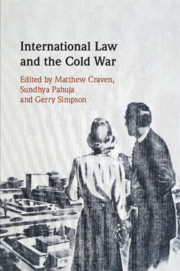Book contents
- International Law and the Cold War
- International Law and the Cold War
- Copyright page
- Dedication
- Contents
- Figures
- About the Editors
- About the Authors
- Acknowledgements
- 1 Reading and Unreading a Historiography of Hiatus
- Part I The Anti-linear Cold War
- Part II The Generative/Productive Cold War
- 4 Accounting for the ENMOD Convention: Cold War Influences on the Origins and Development of the 1976 Convention on Environmental Modification Techniques
- 5 Nuclear Weapons Law and the Cold War and Post–Cold War Worlds: a Story of Co-production
- 6 Parallel Worlds: Cold War Division Space
- 7 Shadowboxing: The Data Shadows of Cold War International Law
- 8 Contesting the Right to Leave in International Law: the Berlin Wall, the Third World Brain Drain and the Politics of Emigration in the 1960s
- 9 Bridging Ideologies: Julian Huxley, Détente, and the Emergence of International Environmental Law
- 10 More than a ‘Parlour Game’: International Law in Australian Public Debate, 1965–1966
- 11 Environmental Justice, the Cold War and US Human Rights Exceptionalism
- 12 The Cold War and Its Impact on Soviet Legal Doctrine
- 13 Forced Labour
- 14 Rupture and Continuity: North–South Struggles over Debt and Economic Co-operation at the End of the Cold War
- 15 The Cold War History of the Landmines Convention
- Part III The Parochial/Plural Cold War
- References to Cold War Volume
- Index
12 - The Cold War and Its Impact on Soviet Legal Doctrine
from Part II - The Generative/Productive Cold War
Published online by Cambridge University Press: 05 December 2019
- International Law and the Cold War
- International Law and the Cold War
- Copyright page
- Dedication
- Contents
- Figures
- About the Editors
- About the Authors
- Acknowledgements
- 1 Reading and Unreading a Historiography of Hiatus
- Part I The Anti-linear Cold War
- Part II The Generative/Productive Cold War
- 4 Accounting for the ENMOD Convention: Cold War Influences on the Origins and Development of the 1976 Convention on Environmental Modification Techniques
- 5 Nuclear Weapons Law and the Cold War and Post–Cold War Worlds: a Story of Co-production
- 6 Parallel Worlds: Cold War Division Space
- 7 Shadowboxing: The Data Shadows of Cold War International Law
- 8 Contesting the Right to Leave in International Law: the Berlin Wall, the Third World Brain Drain and the Politics of Emigration in the 1960s
- 9 Bridging Ideologies: Julian Huxley, Détente, and the Emergence of International Environmental Law
- 10 More than a ‘Parlour Game’: International Law in Australian Public Debate, 1965–1966
- 11 Environmental Justice, the Cold War and US Human Rights Exceptionalism
- 12 The Cold War and Its Impact on Soviet Legal Doctrine
- 13 Forced Labour
- 14 Rupture and Continuity: North–South Struggles over Debt and Economic Co-operation at the End of the Cold War
- 15 The Cold War History of the Landmines Convention
- Part III The Parochial/Plural Cold War
- References to Cold War Volume
- Index
Summary
The Cold War had numerous effects on Soviet political transitions and internal affairs, but its impact on Soviet legal doctrine was underestimated and profound. As Hans Kelsen acknowledged: ‘Soviet legal theory adapts itself submissively to every change of the Soviet government’.
But how did Soviet legal doctrine and theory manage this task, and why did the Soviets embrace forms of liberal legalism at the height of the Cold War? This chapter answers the first question by showing how, in order to effect this ‘submission’, Soviet legal doctrine and theory adopted combinations of hard positivism, hermetic monism, indeterminacy in the service of national interest and an extreme liquidity of legislation during the Cold War.
Keywords
- Type
- Chapter
- Information
- International Law and the Cold War , pp. 256 - 270Publisher: Cambridge University PressPrint publication year: 2019

